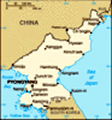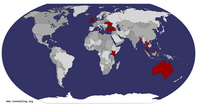COMING SOON HOUSE ADVERTISING ads_leader
In a country renowned for its international isolation, North Korea is equally adept at isolating foreigners visiting their nation. I have never journeyed to a country where I was kept so separated from the local populace. On almost every occasion, we were deliberately distanced from the local people; we would always eat in the most secluded section of a restaurant, be ushered out of a separate entrance/exit to a performance or show - and if this was not possible, then only after had we exited the building, would the North Koreans be allowed the leave the same premises. We effectively experienced the country as a detached observer.
The incidental contact with local people which can be such a rewarding part of travel was non-existent. It was not possible to chat to someone next to you on a bus, in a restaurant or on the street. Only once during my nine days in North Korea did I converse with someone on a level other than the “you are my customer” mode. It occurred at a North Korean monument and whilst everyone else was attending to other matters outside, a young lady who worked there approached me and asked about my country.
She explained to me the difference between the North and South Korean dialects and I discussed the different variations of English between the US, UK and Australia. Three minutes later, we heard approaching footsteps, and she hurried back to her work area and seamlessly adopted the typically cool demeanour of North Korean hospitality staff.
Even our visit to the Metro, where we hoped to mingle with the citizens of Pyongyang going about their daily activities proved disappointing in this regard. We were deposited outside one station and descended deeply into the bowels of Pyongyang down a very steep and long escalator - I wonder if this underground transport network also substitutes as a bomb shelter if required. If you are tired of advertising at Metro stations, then visit Pyongyang, for there is absolutely none to be seen. After leaving the escalator, we strolled through an archway and entered the platform - it was an area resplendent with marble, mosaics and chandeliers - the word palatial comes to mind. Following a permitted period of photographing, we boarded a rickety carriage where inward facing seats lined the walls. Not surprisingly, the carriage was devoid of any advertising, except for two portraits
of the Great Leader and Dear Leader who solemnly observed our movements. The other passengers avoided looking at us as if they were forbidden to show any interest in foreigners; quite different from many parts of the country where it was common for people to stare as we drove or walked past.
After trundling along the tracks for a few minutes, we creaked to a stop at the next station and disembarked. Another beautifully presented station greeted us, and after another long escalator ride we exited the station onto the streets of Pyongyang. Interestingly our bus was waiting on the pavement only a few metres from the exit and not on the nearby road where one would expect a bus to be parked. This action denied us the chance to briefly walk along Pyongyangs streets, again removing the possibility of any unintended and incidental contact with the local people.
Our Guide and Official controlled our every movement and action; they rarely allowed us to stray far from their side and never out of their gaze. Even in some of our accommodation, our North Korean hosts would stay in an adjacent room which meant that they could scrutinise our
movements. Other North Koreans dutifully supported this controlled environment. Whenever we entered the foyer of the hotel to await our day’s travels, the concierge would immediately make a telephone call to inform whoever was on the other end that the “Australians” had arrived. Sure enough, within a couple of minutes, our Guide would saunter forth. It was this extreme control that made North Korea the safest country I have ever travelled in - there was no chance of being the victim of any crime, since nobody could get close enough to engage in any villainous activity.
This control even extended to “staged” events, instances intended as a glimpse of North Korean life, but were actually rehearsed to provide us with a positive impression. The most noticeable event was our visit to Moranbong Hill in Pyongyang on National Day (September 9). We were informed that we would witness North Koreans at leisure, and I have no doubt that some of this was genuine as we saw much singing and dancing. However, I was invited (i.e. forced) to join in the local dancing, which involved me being swooned over by short, elderly North Korean woman with bad teeth. My dance invite
came from a young man who pulled me into the dancing circle with the words “Come and dance”. Strangely, I was unable to get many other English words out of him (not even his name) and it appeared his English instruction was limited to this initial phrase. His behaviour was so forthright and different from the usual North Korean manner, that we could only deduce that this invite was rehearsed. Interestingly, tourists on another tour group had a similar experience on the Hill that day - and it included dancing with elderly North Korean women. Regardless of the motive for this incident, it was still a superb experience.
Later that same day we visited the Mangyongdae Fun Fair, North Korea’s version of a theme park. It was filled with many dilapidated rides that would cause a workplace safety inspector to suffer seizures at every turn. There did not appear to be any rehearsed events as the usual cautiousness of North Koreans to foreigners was again on display. We witnessed many groups enjoying a family outing; a similar scene to anywhere else in the world, and I even rode the merry-go-round, a large contraption residing in an embellished concrete building.
I easily resisted the temptation to ride on the rollercoasters, whose rusted frames would make any ride a perilous adventure.
One of the most fascinating locations we visited in Pyongyang was the Russian Orthodox Church - a place that sees so few visitors (even by North Korean standards) that we were constantly photographed by a staff member of the church. Obviously photography restrictions did not apply to the locals. We were introduced to the priest, a quietly spoken and peaceful man possessing great knowledge about religion - both Fi and I warmed to him immediately. However, he runs a church without any parishioners - no North Koreans followed the Orthodox religion, nor do any of the expatriate Russians. This was a mysterious place, but for the most unusual of reasons.
Most of our travel was within Pyongyang, a city of over three million people, but a contradiction in many ways. Though it had imposing (yet sterile) buildings, modern skyscrapers, and wide boulevards - there was no other modernity - traffic was sparse, the buses decrepit, and very few pedestrians. On a smaller scale, even the international standard hotels would house dated relics - dial telephones and push button
television sets (with no remote control) being just two examples. But most intriguing was the lack of commercialism - imagine a very large city and totally remove the retail sector - no advertising, billboards, neon signs, shopping malls, or gleaming shops that entice shoppers into their stores.
Into this odd mix was thrown the traffic controllers - young, beautiful women with well-defined calf muscles, and adorned in smart white and aqua uniforms. If only all traffic controllers in the world looked so good, and seeing them always added a little excitement to each day. They would twist and spin with great alacrity on covered podiums in the middle of each intersection. These controllers were used instead of traffic lights, and when I suggested that there were no such lights in Pyongyang, the Guide pointed to one as we drove by - but it was not working.
Upon leaving Pyongyang, we noticed a significant difference between the standard of living in the capital and the rest of the country. Roads had no street lighting, and several of the three-four star hotels we stayed in either had no electricity or no hot water - or both. Considering foreigners would stay
in the best facilities within each town, it did not say much for the situation of the locals. This lack of lighting explains why night images of North Korea taken from satellites show the country shrouded in darkness while the neighbouring South Korea and China are brightly festooned with lights. In these smaller towns we also heard the morning pronouncements blaring through loudspeakers. They would commence at seven in the morning and would exhort the local villagers to work harder (or something similar) in order to fulfil the
Juche or communist ideal. This was old Soviet-style propaganda at its best.
Being away from Pyongyang provided a crucial insight into the North Korean psyche. As is usual, the behaviour of children provides the keenest indicator. Children react differently to travellers in different parts of the world; in Africa, Middle East and India ebullient children will chase you for attention. In Europe and much of Asia, they are indifferent, but North Korea is the first country I have visited where children would hide when a foreigner approached.
Perhaps this can be attributed to the government practice of placing children in 24 hour government childcare institutions. Between the ages of one
to four, children will spend approximately five days and nights per week away from their parents. It is during these formative years that they are taught the wonders of the Great Leader and the perils that foreigners can bring. Consider the Jesuit saying, “Give me a child until he is seven and I will give you the man”, and you will understand the decisive impact this practice has upon these impressionable minds. On the day before we departed I asked our Guide whether it was accurate to presume that the North Koreans loved the Great Leader more than their own families. A correct assumption I was told, and though this was not unexpected, it was still a surprise.
On only one occasion did children openly welcome us, and this was at the Sariwon City Folk Custom Street where rehearsals were underway for the National Day celebrations. Curious children flocked to our small bus when they saw me - there is no hiding a Caucasian in this part of the world. Their cherubic faces beamed and sneaked glances at me even when instructed by their teacher not to do so. Normally, children would just stare at me in amazement, so
this experience was a pleasant change.
However, the most telling incident occurred at the historic Dangun Mausoleum. Shortly after we arrived, a large group of approximately 60 schoolchildren (6-8 years of age) and under the watchful eyes of accompanying adults, appeared on the other side of the road from where I stood - a distance of some 50 metres. While waiting for the local site guide, I walked a few steps towards the children and they immediately ducked to hide behind a small barrier - it was perhaps the first time they had ever sighted a Caucasian. The adults did not move. I was rather nonplussed by this event.
A minute had elapsed and the children were still hidden from view, so I decided to resort to that universal sign of friendship - the wave. I lifted my arm and began to wave with long sweeping movements. Ten seconds later, one of the children from behind the barrier raised their hand and waved in return, and so did one of the teachers. This prompted many more small hands to suddenly emerge from behind the barrier and soon all the children had stood and were vigorously waving with great
excitement. Maybe, but just maybe, I had changed their perception by a minuscule degree that foreigners are not always the dangerous and feared aggressors of their imaginings and teachings.
COMING SOON HOUSE ADVERTISING ads_leader_blog_bottom
Tot: 0.099s; Tpl: 0.02s; cc: 16; qc: 50; dbt: 0.0495s; 1; m:domysql w:travelblog (10.17.0.13); sld: 1;
; mem: 1.2mb
































Donna and Neil
Donna and Neil
Fascinating...
Hi Shane...another well written and very fascinating blog. We are really enjoying your insights about such an isolated and insular country. How strange with the children, you are right in other parts of Asia they do at least have a good stare (or point!) at the foreigners but we suppose if they have been indoctrinated (for lack of a better word) from such an early age its easy to see why they viewed you with suspicion. We notice the bedside table the dial phone is sitting on has radio-type buttons were you lucky enough (?) to get the daily broadcasts through that too or just some nice elevator music?! Looking forward to your next blog.